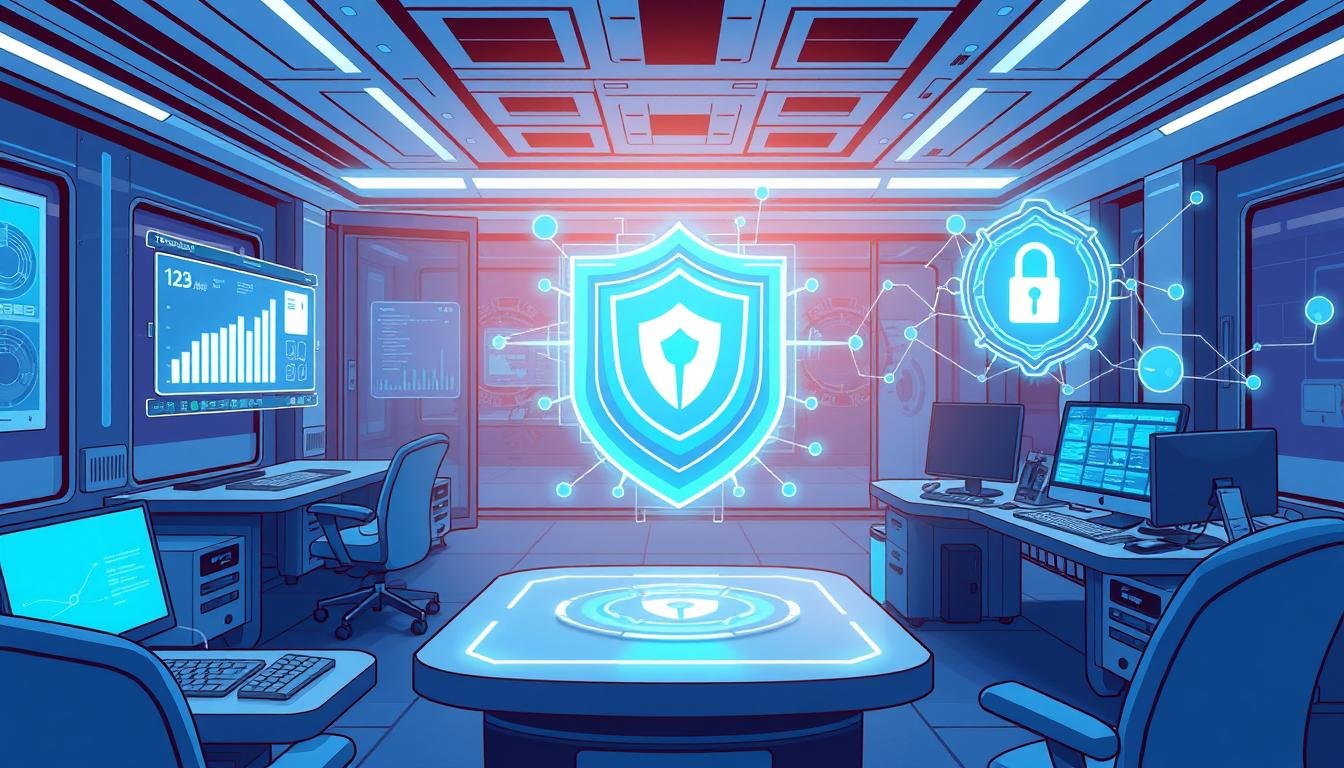Cybersecurity Trends: How Businesses Can Stay Ahead in 2025
Are you ready to face the fast-changing threats to your business’s digital safety?
Cyberattacks are getting smarter and more common. It’s now a must to stay ahead. The world of cybersecurity is changing fast, thanks to more connected devices and new ways to attack. Businesses must keep up with these cybersecurity trends to protect their data and keep customers’ trust.
Using AI to defend against cyber threats can cut down response times by up to 60%, says Gartner. IBM Security’s report shows that almost half of all cyber incidents were due to endpoint breaches. As companies focus on security, using zero-trust models and solid incident response plans is key. Following new data privacy regulations is not just to avoid fines but to build a secure future.
Adopting new strategies, like advanced threat detection and real-time checks, can help businesses outsmart cybercriminals in 2025. The sooner a business can spot and act on threats, the safer it will be.
Key Takeaways
- AI-driven security solutions can reduce threat response times by up to 60%.
- Zero Trust Architecture has led to a 45% reduction in security incidents.
- Endpoint-related breaches accounted for 48% of all incidents in 2024.
- Non-compliance with cybersecurity regulations can result in fines of up to $20M.
- Implementing well-documented Incident Response plans can reduce breach recovery times by 35%.
Adopting AI-Powered Threat Detection
As cyber threats grow, using AI-powered threat detection is key for keeping digital assets safe. These systems use machine learning to check data non-stop. They spot oddities that might mean a cyberattack is coming.
Being quick to respond to threats is crucial. It helps prevent big damage from breaches.
Real-Time Anomaly Detection
Real-time anomaly detection is a big plus of AI solutions. They watch user actions and network traffic live. This lets them catch unusual patterns that might mean trouble.
For example, sudden network traffic spikes or odd user actions get flagged right away. This means businesses can act fast to stop threats before they get worse.
Automated Response Systems
Automated response systems are vital in today’s cybersecurity. They handle threats well and with little human help. This makes attacks easier to manage, cutting downtime and data loss.
Automated actions include isolating systems, alerting IT, and starting security steps.
Staff Training for AI Systems
To get the most from AI threat detection, staff need comprehensive training. Good training helps them understand AI alerts and act on them. This human touch is key to using tech for real-world security.
| Threat Detection Capability | Traditional Methods | AI-Powered Methods |
|---|---|---|
| Data Analysis Speed | Slower | Real-time |
| Anomaly Detection Accuracy | Moderate | High |
| Response Time | Delayed | Instant |
| Resource Efficiency | Higher Costs | Optimized Costs |
With cybercrime damages set to hit $10.5 trillion by 2025, moving to AI is urgent. AI threat detection boosts accuracy and speed. It also offers scalable solutions for all sizes of businesses.
Implementing Zero Trust Architecture
Zero Trust Architecture is key in today’s cybersecurity. With more complex cyber-attacks, just trusting internal network traffic isn’t enough. Verifying every connection and access attempt is crucial.
Multi-Factor Authentication
Security is a top priority with Zero Trust. Multi-Factor Authentication (MFA) is a must. It requires more than one form of verification to reduce risks from stolen passwords.
For example, employees might need a password, a fingerprint, and a code from an app. This creates a strong defense against unauthorized access.
Network Segmentation
Network Segmentation is vital in Zero Trust. It divides a network into smaller parts. This limits how far a breach can spread.
Micro-segmentation takes it further by creating even smaller segments. It ensures any breach stays contained, protecting the whole system.
With more remote workers and cloud services, security is more important than ever. The remote workforce is expected to grow to over 36 million next year. Cloud computing is also set to double soon. This makes Zero Trust Architecture essential for protecting data and operations.
| Security Measure | Implementation | Benefits |
|---|---|---|
| Zero Trust Architecture | Verify user, device, and network connection | Reduces risk of unauthorized access |
| Multi-Factor Authentication | Require multiple verification forms | Minimizes compromised credential risks |
| Network Segmentation | Create isolated network segments | Contains breaches and limits spread |
Enhancing Cloud Security
The rise in cloud technology has made cloud security more important. With 60% of corporate data in the cloud, protecting it is key. Businesses need strong access controls and encryption to keep data safe from hackers.
Access Controls and Encryption
Using Identity and Access Management (IAM) with multi-factor authentication (MFA) is crucial. It helps control who can access cloud data. Data encryption, both at rest and in transit, is also vital for cloud security.
Continuous monitoring and threat detection are also important. Companies can improve security by working with cybersecurity experts. This includes consultants and managed security service providers (MSSPs).
Compliance with Cloud Security Frameworks
Following cloud security frameworks, like those from the Cloud Security Alliance (CSA), is essential. It ensures businesses meet regulatory standards. Data classification is also key to protect sensitive information.
Recovery Solutions for Cloud Environments
Having recovery plans for cloud environments is vital. It helps restore services quickly after a cyber attack. Regularly reviewing and updating these plans is crucial.
Cloud Security Posture Management (CSPM) tools are becoming more popular. They help monitor cloud configurations. Solutions like SASE and Multi-Cloud Security also improve security across different clouds. By following best practices, businesses can keep their digital assets safe.
Strengthening Ransomware Prevention Strategies
Ransomware attacks are getting more common. It’s vital for businesses to boost their defense. Using Data Backups, training employees, and having Incident Response Plans are key to staying safe.
Regular Data Backups
Data Backups are a must. They help restore data quickly, avoiding ransom demands. Regular checks and backups are crucial. Testing your backups against ransomware is also important.
Employee Awareness and Training
Training employees to spot ransomware threats is crucial. Only 23% of companies worldwide teach about vishing in their training. This knowledge helps catch threats early, like phishing and vishing.
Incident Response Plans
A good Incident Response Plan helps react fast to ransomware. Companies should have plans ready for ransomware attacks. These plans should include quick detection and keeping systems up to date.
| Aspect | Statistics for 2021 |
|---|---|
| Organizations Attacked | 66% experienced a ransomware attack |
| Increase in Attacks | 37% rise over previous year |
| Average Ransom Payment | $800,000 |
| Average Cost of Attack | $4.62 million |
| Phishing Initiated Attacks | 41% |
| Vishing Training Coverage | 23% |
By using Data Backups, training, and Incident Response Plans, businesses can fight ransomware better. This keeps their operations safe.
Managing Insider Threats
Protecting an organization’s key assets from insider threats is crucial. These threats come from malicious, negligent, or compromised insiders. They also include temporary workers and vendors. It’s important to know these types and have strong Insider Threat Management plans to reduce risks.
Setting up strict access controls is a key step. Cybersecurity frameworks like CIS 18 or NIST CSF guide this. They ensure access is limited and follow the principle of least privilege. Without these controls, threats can harm growth and innovation.
Regular security checks and monitoring systems are vital. Tools like SIEM, EDR, network segmentation, and Privileged Access Management help spot suspicious actions. This early detection is crucial.
Training employees is a big part of Insider Threat Management. They need to know how to protect data and spot phishing. Regular phishing tests and security talks keep them up to date and promote a culture of security.
| Statistic | Impact |
|---|---|
| 76% of companies faced insider threats in 2024 | Highlighted the need for enhanced Insider Threat Management strategies. |
| Insider threats can cause financial repercussions | Organizations face costs for investigating and remediating breaches, legal fees, and fines. |
| Human error is a leading cause of breaches | Emphasizes the importance of employee training and awareness programs. |
Using outcome-driven metrics (ODMs) helps measure the success of Insider Threat Management. Gartner’s report shows more businesses are using Continuous Threat Exposure Management (CTEM) strategies. This is because attack surfaces are growing fast.
Creating a security-aware culture is also key. Security Behavior and Culture Programs (SBCPs) help address human weaknesses in cybersecurity. They show the importance of being proactive in Insider Threat Management.
Prioritizing Cyber Resilience Strategies
The world of cybersecurity is changing fast. Businesses must focus on Cyber Resilience Strategies to stay safe. Cybercrime costs are expected to hit $8 trillion in 2023. Companies are spending more on security, with a 64% increase in spending after attacks.
Proactive Threat Hunting
Proactive Threat Hunting is key to finding vulnerabilities before they’re used. It keeps organizations ahead by looking for threats before they happen. Using frameworks like ISO 27001 or NIST Cybersecurity Framework helps strengthen defenses and adapt to new threats.
Regular Security Audits
Regular Security Audits find weaknesses in defenses. They help improve risk management by checking security often. These audits also help meet regulations and build trust with stakeholders.
Continuous Monitoring and Recovery
Continuous Monitoring and Recovery are vital for cyber resilience. Real-time monitoring catches incidents fast, which is important since 70% of threats come from outside. Quick recovery keeps business running smoothly, protecting data and keeping operations going.
Creating a strong cyber resilience plan helps businesses fight and recover from cyber threats. Frameworks like The Cyber Resilience Review (CRR) boost defenses and support business growth. Working together, sharing information, and being adaptable will be crucial for cyber resilience in 2025 and beyond.
Conclusion
Looking ahead to 2025, the digital world needs businesses to keep improving their cybersecurity. They must invest in new tech like AI and Zero Trust systems. These tools help spot threats fast, respond quickly, and keep networks safe.
Also, making cloud security stronger is key. This means better controls, encryption, and following top security rules. With attacks getting worse, protecting cloud data is more vital than ever.
It’s also important to teach employees about cybersecurity. Since most breaches come from human mistakes, training is essential. With more people working from home, and many not trusting companies with their data, this is even more critical.
In 2025, the CISO’s role will grow. They will help manage big security issues and explain complex threats. Businesses must stay alert and keep up with new threats to protect their data and keep running smoothly.
Source Links
- How Businesses Can Improve Their Cybersecurity Posture in 2025
- BitLyft Unveils Top Cybersecurity Predictions for 2025 and How Companies Can Stay Ahead
- AI In Cybersecurity: Staying Ahead Of Emerging Threats
- Emerging AI Trends in Cybersecurity: How SMBs Can Stay Ahead of the Curve
- Cybersecurity Trends: Protecting Business Information in 2025 | Park University
- The Rise of Zero-Trust Architecture: What It Means for Your Business – Brightline Technologies
- How To Effectively Implement Zero Trust Security
- Enhancing Cloud Cyber Security for Businesses – Bestarion
- Top 5 Cloud Security Trends to Watch in 2025
- The Future of Cloud Security: Trends and Innovations to Watch
- 6 Tips to Strengthen Your Ransomware Prevention Plan
- How To Protect Your Business Against Ransomware Attacks
- Cybersecurity Insider Threats – Blue Goat Cyber
- How To Detect, Mitigate, & Prevent Insider Threats
- Gartner’s Top 9 Cybersecurity Trends for Your Business – Obviam | A Cybersecurity Company
- The Ultimate Guide to Cyber Resilience | CybeReady
- 8 Upcoming Cybersecurity Trends in 2025
- How to drive cybersecurity as a top business priority
- Cybersecurity: The 5 Key Trends Every Business Needs to Know
- 2025 Cybersecurity Trends: Nine Ways the Future Could Thrill, Challenge, and Surprise Us








